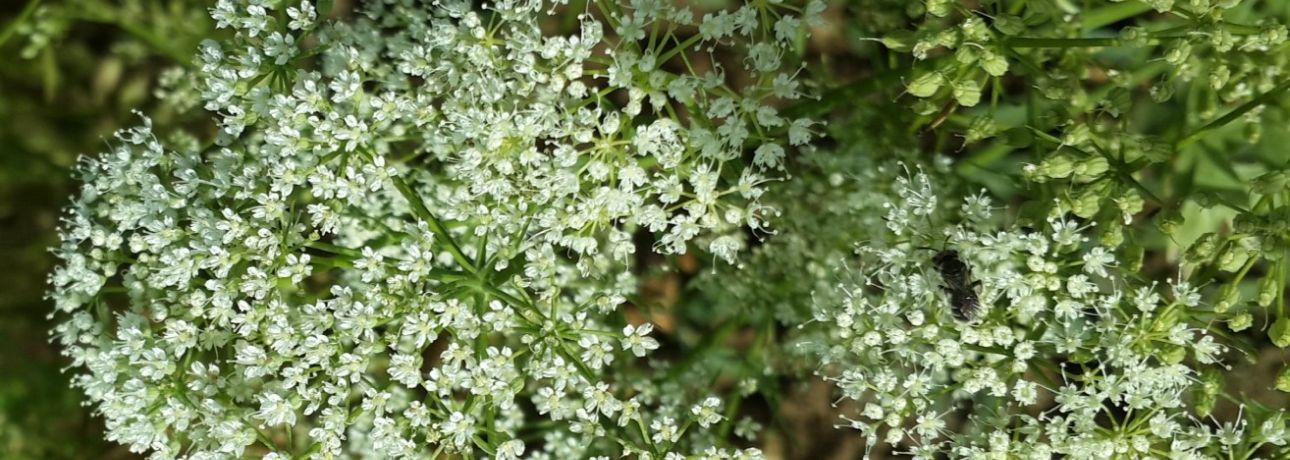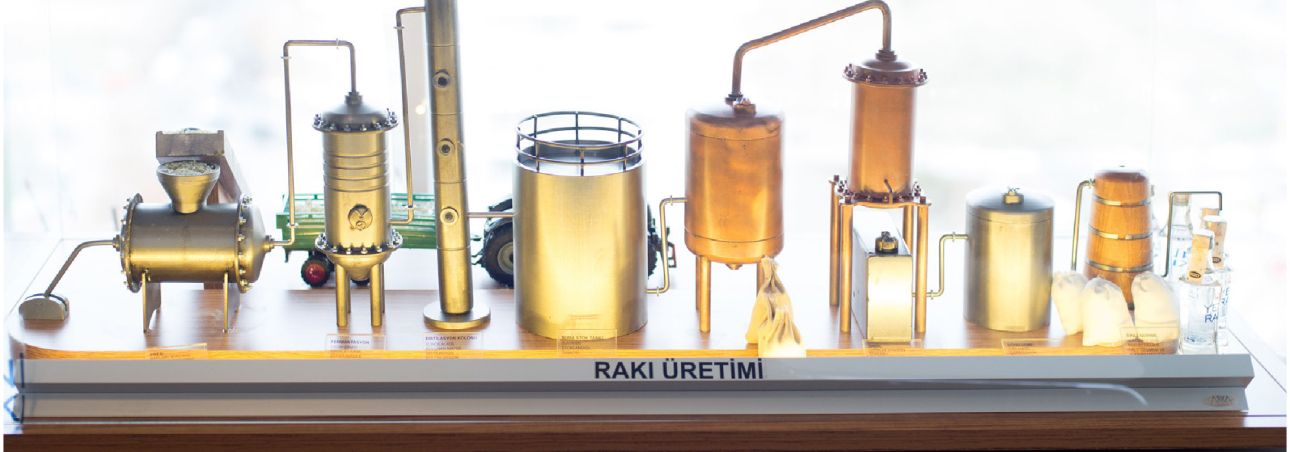- Home
- Our Brands
- Raki
Raki
Raki in 12 Points
- Anise (Pimpinella anisum) that is grown in Turkey is used.
- Raisins, fresh grapes and agricultural products that are grown in Turkey are used.
- It is distilled in Turkey in copper stills with a maximum capacity of 5,000 l.
- At least 65% suma must be used
- The alcohol content must be at least 40%.
- The anethole content in the essential oil from the aniseed must be at least 800 milligrams per liter of the product.
- A facility with a production volume of 1 million liters is required for raki production.
- In case of use of refined white sugar, the amount of sugar used must be at most 10 grams per liter of product.
- No colorants are used in raki production.
- Raki must be rested for a period of at least one month before filling.
- No additives are used.
- According to the geographical indication registration, water is not a component that contributes to the distinctive characteristic of raki.
Definition of Raki
With its smell permeated the centuries old Anatolian culture, raki, today, is protected by laws with its legal definitions. Today, in order for it to be called raki, it must be made in our country with the raw materials grown only in Turkey with the advantage of the fact that anise (Pimpinella anisum), one of the powerful cultural symbols of the Mediterranean, had been blended with the grape culture of Anatolia throughout history.
The fact that anise grown in Cesme and Burdur have been considered the best quality anise in the Mediterranean throughout history because of their strong flavor is a source of pride for Anatolia. It comes out from the second distillation of suma, the alcohol distilled from Anatolian grapes, with aniseed in traditional copper stills, which is distillation of its alcohol content. In short, the legal definition sets the following standards to maintain the quality standard of raki:
It is a distilled alcoholic beverage produced only in Turkey by second distillation of sole suma or suma
mixed with ethyl alcohol of agricultural origin with
aniseed (Pimpinella anisum) in traditional copper still with a volume of 5000 liters or less.
So, raki has a geographical indication and is native to our country.


Our brands under the category of raki, which is believed to date back to 500 years ago, consists of Yeni Raki, Tekirdag Raki, Kulup Raki, Altinbas, Izmir Raki, Civan Raki and Tayfa Raki. Following the abolition of the state monopoly on alcoholic beverages and and privatization of the industry in Turkey, the way was paved for raki production by the private sector for the first time in 2001. In accordance with this law, the definition stating "Raki, which is produced by a second distillation of suma, a grape-based distillate, or suma mixed with agricultural ethyl alcohol in traditional copper stills of five thousand liters or of a smaller volume with aniseseed, must be produced in Turkey and at least 65% of the total alcohol contained in the product must consist of suma." was introduced in Article 3 of the Law Nr. 4250.
Our Brands
| YENI RAKI | TEKIRDAĞ RAKI | KULÜP RAKI | ALTINBAŞ |
| İZMİR RAKI | CİVAN RAKI | TAYFA RAKI | VEFA RAKI |
As can be seen, the definition of raki plays an important role in history, and it has been governed and subjected to both specific provisions as an alcoholic beverage and general provisions as a foodstuff. However, introduction of the definition of raki in the law in 2001 is of importance. In this way, the state was no more the sole producer and new producers entered the market with the adoption of the free market model, and traditional raw materials and the production process of raki were preserved, thus securing the future of raki. In 2009, "raki" was registered with a geographical indication by the Turkish Patent Institute and was taken under preservation. We, as Mey|Diageo, preserve the heritage inherited to us, and are committed to the traditional ways of raki production and drinking, bring 500 years of history to the present with its unique style. With every new product we introduce to our portfolio, we aim to preserve the specific manner of raki.

Brief History of Raki
Raki Culture
It is derived from the Arabic word "arak", which means sweat. It is also suggested that it is called Raki because it was first made from Razaki grapes. "Beng u Bade" of Fuzuli was the first written source it was mentioned, and it was referred to as "arak".
Raki was also mentioned in Seyahatname (Book of Travel) by Evliya Celebi in the 17th century, and started to be consumed widely in the 19th century.
Geographical Indication
It is defined as "a product that is produced using traditional raw materials or is characterized by a traditional composition or a method of production that corresponds to a traditional production method or is clearly distinguishable from similar products under the same category as it has undergone processes reflecting such method of production even if it has not been directly based on a traditional production method" (Turkish Patent, 2018).
Local products, which are referred to as specific cultural heritage, are evaluated as specific products because of their characteristics specific to a certain area, and the traditional processes they undergo with raw materials specific to that area give them distinctive characteristics.
The production, raw material and process definitions of raki are set out in the Distilled Alcoholic Beverages Communiqué under Turkish Food Codex (Communiqué no: 2016/55, Annex-1, Item A). Raki has a registered geographical indication in Turkey.
How is Raki Made?
Who made the first raki? Even though this frequently asked question has no clear answer, we know that its current form comes from centuries old evolution. First of all, raki making requires a still mechanism for the distillation process to take place. It is the common opinion of the experts that the word raki comes from the Arabic word arak, which means "sweat". The product flow during the distillation process by making use of a still is likened to sweating, and the product dripping slowly from the still is likened to a drop of sweat. The resultant mash after fermentation of the grapes is distilled into suma, which is concentrated alcohol of grapes. Alcohol is 'thinned out' by adding water to suma, the maximum alcohol content of which is 94.5 degrees. Then, anise is added and a second distillation with anise takes place in copper stills.
Copper Still
Copper still is considered an indispensable traditional method because it is a great conductor of heat and brings out the aroma of the grapes by distillation of alcohol. It features a vessel in which distilled suma is boiled, a pipe to transfer the alcohol, which reaches to the boiling point with the heat before the water does and evaporates, and a cooling unit to condense and liquefy the steam.
The technique of distillation based on still was first developed by Arab and Persian chemists in Mesopotamia in the 8th and 9th centuries. The sources belonging to a period, when Islam had its golden age in science and philosophy, reports that Câbir Bin Hayyan described production of distilled spirits from wine in detail. However, this assertion could not be documented. The earliest known work on distillation of alcohol in the still was written by Magister Salernus in Italy in the 12th century. Today, the maximum capacity of copper stills used in raki production is limited to 5,000 liters in accordance with legally protected standards of raki.
How to Taste Raki
Visual Evaluation
The color tone and clarity are checked. A look straight down into the glass and through the side of the glass is given. Then a tilt is given to the glass and it is checked again. A swirl is given to have an idea about the color tones, density and fluidity.
Smell Evaluation
Its aromatic structure is evaluated by sniffing. The glass is held still and the product is sniffed. Firstly, the easily volatile primary smells and then the secondary smells, which are hardly volatile and revealed later on by giving it a swirl and taking a short and deep breath in, are perceived. *After dilution, appearance and smell inspections are repeated.
Taste Evaluation
It is the evaluation done by tasting. After dilution, a sip of raki with air is taken into the mouth and is held for 1-2 seconds without swallowing. Then the air is breathed out to identify the flavors lingering on the tongue, palate and throat. *Tasting undiluted raki is not recommended as it will numb the taste buds, which help us distinguish tastes, due to high alcohol content.
Mouthfeel and Overall Evaluation
The mouthfeel is the intensity, fullness, smoothness, strength and burning sensation in the mouth and on the palate. The overall evaluation includes evalution of the criteria such as drinking quality, characteristic, balance and mouthfeel by checking the harmony of texture and taste.
What Does Raki Mean?
It is derived from the Arabic word "arak", which means sweat. It is also suggested that it is called Raki because it was first made from Razaki grapes. "Beng u Bade" of Fuzuli was the first written source it was mentioned, and it was referred to as "arak". Raki was also mentioned in Seyahatname (Book of Travel) by Evliya Celebi in the 17th century, and started to be consumed widely in the 19th century.
What is Arak?
The word "Arak", which means sweat in Arabic, started to be used to define distilled products since the product flow during the distillation process by making use of a still was likened to sweating, and the product dripping slowly from the still was likened to a drop of sweat. Regardless of lingual, regional and cultural differences, it has been the common name of various distilled spirits made by use of stills in a wide geography stretching from East India to the Middle East and North Africa, from Central Asia to Eastern Europe throughout history.
What is Distillation?
As used in the production of alcoholic beverages, it is the process, where alcohol strength is increased by first evaporation and then condensation of the mash, which is obtained from fermentation and has an alcohol strength of approximately 10-15%, by special devices, and undesired fermentation by-products are eliminated. In a more general sense, distillation is the process, where compounds dissolved in each other are eliminated by taking advantage of the difference in boiling points.
What is Mash?
It is the by-product obtained when sugars contained in the agricultural products undergo alcohol fermentation under appropriate conditions with addition of yeast, and has an alcohol strength of approximately 10-15% alcohol, depending on the process. It is used in alcohol production.
What is Suma?
It is the alcohol obtained by distillation of the mash, i.e. wine, resulting from fermentation of fresh grapes or raisins, i.e wine, up to a maximum alcohol strength of 94.5% in such a manner that rich aromas and smell of grapes are preserved.
What is Still?
The equipment used for distillation process is called still. Stills are generally made of copper, and according to Turkish Food Codex, it is a requirement for raki production. Raki production in stills is a discrete production process, and the product is obtained in a slower manner and requires experience.
What is a Distilled Spirit?
It is an alcoholic beverage with a high alcohol strength, ranging from minimum 15% to maximum 40%-50%, and it is obtained by distillation of the alcoholic mixture, which results from fermentation and is called mash, in equipment that is in compliance with the process definition, which is followed by appropriate final processes. Turkish Food Codex includes distilled spirit definitions and categories under different headings. Accordingly, alcoholic beverages of different combinations, which are obtained by direct distillation of natural fermentation products and/or maceration of herbs (i.e., extraction by maceration in alcohol) and in which flavoring agents, sugar and similar sweetening agents can be added, are called distilled spirits. In case of addition of aroma and different components in distilled spirits, it must be produced in accordance with the Distilled Alcoholic Beverages Communiqué under Turkish Food Codex. The general definition of distilled spirit includes products such as liqueur, vodka, whiskey, gin, and raki. Raki is defined under a separate category within distilled spirits in the Turkish Food Codex, and its country of origin marking, production basis in order to maintain localness of the product and its characteristics are set out in detail.





